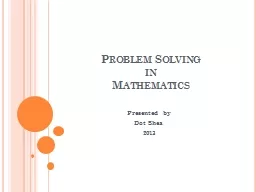

in Mathematics Presented by Dot Shea 2013 Problem Solving Newmans error analysis states that a s tudent wishing to solve a written mathematics problem typically has to work through five basic steps ID: 357416
Download Presentation The PPT/PDF document "Problem Solving" is the property of its rightful owner. Permission is granted to download and print the materials on this web site for personal, non-commercial use only, and to display it on your personal computer provided you do not modify the materials and that you retain all copyright notices contained in the materials. By downloading content from our website, you accept the terms of this agreement.
Slide1
Problem Solving inMathematics
Presented by
Dot Shea
2013Slide2
Problem SolvingNewman’s error analysis states that a
s
tudent wishing to solve a written mathematics problem typically has to work through five basic steps:
1. Reading the problem
2. Comprehend what is read
3. Carrying out a transformation from the words of the problem to the selection of an appropriate mathematical strategy
4. Applying the process skills demanded by the selected strategy
5. Encoding the answer in an acceptable written form.
http://www.curriculumsupport.education.nsw.gov.au/secondary/mathematics/numeracy/newman/index.htmSlide3
1. Reading the ProblemIt is very important to always remember to read the questions to the students when doing word problems in mathematics.
What are you assessing?
The emphasis should be on the mathematics understanding not the ability to read.
All testing of Mathematics (NAPLAN, PAT-M) allows you to read the words (not numbers) to the students.
There will always be students in your class who have more ability in maths than reading.
It is important for these students to show their full potential.Slide4
2. Comprehend what is readFor a student to understand what they have read and know what to do they need to understand what the words in the problem mean.
Mathematical language can be very difficult to understand and can be easily misinterpreted.
Students may:
not understand the spoken or written instructions-such as ‘draw a line
between’..’ring
’....or ‘find two different ways to’
Not be
familiar with mathematical vocabulary-that is, words such as difference, equation.......
be confused about mathematical terms-such as ‘odd’ or ‘table’ which have a different meaning in everyday language.
be confused about other words-like ‘area’, ‘fraction’ or ‘divide’ which are used everyday and have similar though more precise contextual meanings in
mathematics
It is vital to teach mathematical language
explicitly and
have the words displayed so the students can refer to them if necessarySlide5
3. Transformation (Strategies)To work out a word problem the student needs to be able to transform the words of the problem through an appropriate mathematical strategy to solve the problem.
Students need to be explicitly taught different strategies they can use to approach a word problem.
Strategies such as:
Draw a picture
Guess and check
Act it out
Write a number sentence
Find a pattern
Work backwards
etcSlide6
4. Process SkillsMost teachers are very good at teaching skills and the majority of students are able to do process skills such as addition or multiplication.
Can they apply these skills?
“
Research using Newman’s error analysis has shown that 50% of errors occur before students get to use their process skills. Yet many attempts at remediation in Mathematics have in the past over-emphasised the revision of standard algorithms basic facts”
NSW Government Education & CommunitiesSlide7
5 Encoding the answerWhen testing a student on their mathematical ability the question may be in one format and the answers in another format.
This means that the student often has to use their prior knowledge to interpret the answer in the right format.
Sometimes this is interpreted for you, such as in a key in Graphs or maps but often there is an assumption of prior knowledge such as the question in grams but the answer in kilograms.
Students can make mistakes purely because the answer is in a different format. The question might be in a specific format such as a calendar but the answers are in a different format such as a date.Slide8
Newman’s prompts1.
Read
the
question.- We need to read for meaning
.
What
word do you think it could be?
Is there another word you know?
2. What
is the question asking you to find out?
Locate the question.
What
do you think it means?
What
do you think you should do?
3. What could you do to get the answer?
What strategy could you use?
What information have you been given?
What do you know?
Can you record this in some way?
4. Can you solve it now?
What
are the steps to your solution
?
How do you record these steps
so
that it is understood by others not just you
?
Carry out those steps.
5. Can you write your solution?
Have you answered the question?
Is your solution understood by others?
Is your answer in the right format
Slide9
FISHThere are many different resources out there on how to teach problem solving. It is important to specifically teach problem solving, some students will not know how to do it just
by practicing.
Problem solving should be continually revised and could be used as a 10 minute warm up exercise once it has been taught.
The FISH strategy is a good way to teach problem solving.
F- What am I asked to FIND? (include What do the words mean?)
I- What INFORMATION do I already have?
What STRATEGIES and SKILLS do I have to solve /do this task?
How reasonable is my solution. How do I know?Slide10
Why teach Problem solving?Research links
Research based strategies for problem solving in maths
http://floridarti.usf.edu/resources/format/pdf/Classroom%20Cognitive%20and%20Metacognitive%20Strategies%20for%20Teachers_Revised_SR_09.08.10.pdf
Research paper on Problem solving strategies in Mathematics-ACER
http://research.acer.edu.au/cgi/viewcontent.cgi?article=1022&context=aer&sei-redir=1&referer=http%3A%2F%2Fwww.google.com.au%2Furl%3Fsa%3Dt%26rct%3Dj%26q%3Dmath%2520problem%2520solving%2520teaching%2520strategies%26source%3Dweb%26cd%3D8%26ved%3D0CFEQFjAH%26url%3Dhttp%253A%252F%252Fresearch.acer.edu.au%252Fcgi%252Fviewcontent.cgi%253Farticle%253D1022%2526context%253Daer%26ei%3D_gSxUrvhMMWikwWviIDgCg%26usg%3DAFQjCNGuMyq3cYKgXB4l1uSE_vbJPl8CKw#search=%22math%20problem%20solving%20teaching%20strategies%22Slide11
Web Links for teaching problem solving
Problem solving strategies
http://pred.boun.edu.tr/ps/
The Singapore Maths teacher- Maths problem solving strategies
http://thesingaporemaths.com/stratf.html
New Zealand Syllabus- Problem solving activities and teaching sequences
http://nzmaths.co.nz/problem-solving
The Franklin Institute-Open ended maths problems- new ones each month
http://www.fi.edu/school/math2/
Problem solving in Maths-
thinkquest
http://library.thinkquest.org/25459/learning/problem/